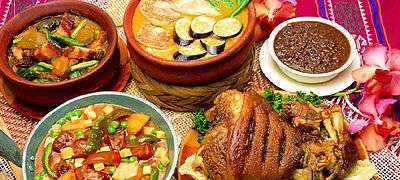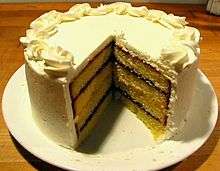Pandan cake
Pandan cake is a light, fluffy, green-coloured sponge cake[4] ("kue"; of Indonesian origin) flavoured with the juices of Pandanus amaryllifolius leaves.[5][6] It is also known as pandan chiffon.[1][2] The cake is popular in Indonesia, Malaysia, the Philippines, Singapore, Vietnam, Cambodia, Laos, Thailand, Sri Lanka, Hong Kong, China, and also the Netherlands, especially among the Indo community, due to its historical colonial ties with Indonesia.[7][8][9][10]
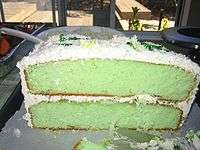 Top: Indonesian pandan cake Bottom: Filipino buko pandan cake with the typical frosting of cream and a filling of macapuno strips | |
| Alternative names | Pandan chiffon cake[1][2] |
|---|---|
| Type | Cake |
| Place of origin | Indonesia[3] |
| Region or state | Southeast Asia |
| Main ingredients | Juice of pandan leaves or Pandanus extract, flour, eggs, sugar, butter or margarine |
Ingredients
The cake shares common ingredients with other cakes, which includes flour, eggs, butter or margarine, and sugar. However, the distinct ingredient is the use of pandan leaf, which give the cake its distinct green colouration. The cakes are light green in tone[11] due to the chlorophyll in the leaf juice. It sometimes contains green food colouring to further enhance its colouration. The cakes are not always made with the leaf juice, as they can be flavoured with Pandanus extract, in which case colouring is only added if a green colouration is desired.[12]
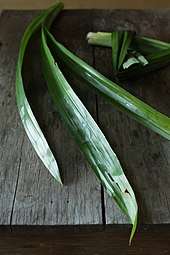
The original pandan cake common in Indonesia, the Netherlands and Singapore are usually soft sponge cake akin to light and fluffy chiffon cake, made without any additional coating or frosting.[2][13] The other variant are actually derived from other cake recipe with similarity only in the usage of green pandan flavouring extract.
In the Philippines, pandan cakes are rarely made with pandan alone, but are made as a buko pandan cake (or coconut pandan cake), from "buko pandan", a traditional pairing of young coconut (buko) and pandan flavours used in various desserts. Philippine pandan cakes generally have strips of coconut meat and/or macapuno as toppings or fillings as a result.[14][15][16] In contrast, pandan cakes in neighboring countries are traditionally served plain.[17]
History and origin
In Southeast Asia, cake-making techniques were brought into the region through European colonization. In the past, Indonesia was a Dutch colony, whilst Malaysia and Singapore were British possessions, and the Philippines was a Spanish colony. Naturally, the European colonists brought their cuisine along with them, with the most obvious impact occurring in bread, cake and pastry-making techniques.[18] In Southeast Asian cuisine, the pandan leaf is a favourite flavouring agent used to give off a pleasant aroma, and added to various dishes ranging from fragrant coconut rice, traditional cakes, to sweet desserts and drinks.[19] It was the fusion of European cake-making techniques with locally grown ingredients that created the pandan-flavoured cake.
In 2017 CNN named Pandan Cake as the national cake of Singapore and Malaysia.[10] This has led to a reaction in Indonesia that regarded the pandan cake, locally known as kue bolu pandan as theirs. In Singapore pandan cake was popularized especially by one of the popular bakery in the city; Bengawan Solo,[13] a cake shop owned by a Singaporean citizen of Indonesian origin.[3]
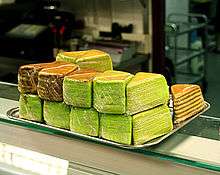
According to CNN Indonesia however, this cake is originated from Indonesia, which can be traced to the cake-making technique of the colonial Dutch people in the Dutch East Indies (now Indonesia) during colonial era.[3] The colonial Dutch and Indos people combined the cake-making technique from Europe with the available local ingredients found in the Indies, in this instance the pandan leaf as flavouring and colouring agent. This cake is also known as pandan cake in Dutch, and is quite popular in the Netherlands due to their historical link to Indonesia. Other than made as chiffon pandan cake, pandan leaf is also used as green colouring and flavouring in Dutch-Indonesian favourite pandan spekkoek or lapis legit (layered cake), which demonstrate the prominence of pandan leaf in Dutch-Indonesian cake and pastry making.[20]
Names in different languages
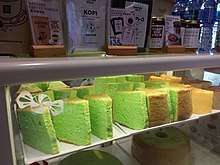
- Indonesian: bolu pandan
- Dutch: pandan cake
- Malay: kek pandan
- Filipino: pandan cake
- Khmer: Num Sleok Touy
- Vietnamese: Bánh pho sĩ, "bánh lá dứa"
- Cantonese: Chinese: 班蘭蛋糕; Cantonese Yale: baan1 laan4 daan6 gou1
- Thai: เค้กใบเตย
See also
References
- Quek, Eunice (30 April 2017). "Is pandan chiffon cake Singapore's national cake?". The Straits Times. Retrieved 20 May 2020.
- "Chiffon Cake Pandan". Holland Bakery. Retrieved 2020-05-20.
- "Mengurai Huru-hara Kue Pandan Singapura". CNN Indonesia (in Indonesian). Retrieved 2020-05-20.
- Hemphill, John; Hemphill, Rosemary (1997). What Herb Is That?. p. 127. ISBN 9780811716345. Retrieved 29 December 2014.
- Jacob, Jeanne; Ashkenazi, Michael (15 January 2014). The World Cookbook. p. 615. ISBN 9781610694698. Retrieved 29 December 2014.
- "Cheap Sweets: Pandan Chiffon". LA Weekly. 22 December 2014. Retrieved 29 December 2014.
- Jeff Keasberry (18 March 2015). "Pandan Cake Pops".
- "Pandan Chiffon Cake". Asian Inspirations. 29 October 2017.
- "Pandan Chiffon Cake". Asian recipe. Archived from the original on 2018-01-16. Retrieved 2018-01-16.
- Zoe Li; Maggie Hiufu Wong (3 April 2017). "Cakes of the world: Tiramisu, baklava, cheesecake and more national treats". CNN. Retrieved 2020-05-20.
- Castella, Krystina (January 2010). A World of Cake. p. 288. ISBN 9781603425766. Retrieved 29 December 2014.
- "Recipe: Pandan chiffon cake with coconut glaze". Los Angeles Times. May 5, 2011. Retrieved November 5, 2011.
- "Welcome to Bengawan Solo". www.bengawansolo.com.sg. Retrieved 2020-05-20.
- Besa-Quirino, Betty Ann (13 June 2012). "How to bake a Pandan – Macapuno Cake". Asian in America. Retrieved 22 April 2019.
- Anastacio, Aileen. "Buko Pandan Cake Recipe". Yummy.ph. Retrieved 22 April 2019.
- "Buko Pandan Confetti Cake". Kawaling Pinoy Tasty Recipes. Retrieved 22 April 2019.
- Tay, Leslie. "How to make a pandan chiffon cake: Almost everything you need to know". ieatishootipost. Retrieved 24 April 2019.
- Luke Nguyen (5 December 2016). "Crocodile bread and spekkoek: the tasty intersection of Dutch-Indo food". SBS.
- Jeanne Jacob; Michael Ashkenazi (2014). The World Cookbook: The Greatest Recipes from Around the Globe, 2nd Edition (4 Volumes): The Greatest Recipes from Around the Globe. ABC-CLIO. p. 615. ISBN 9781610694698.
- "Layered cake pandan". Belimpex. Retrieved 2020-05-20.
